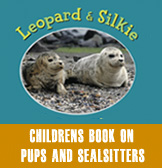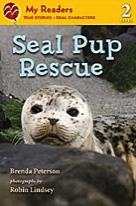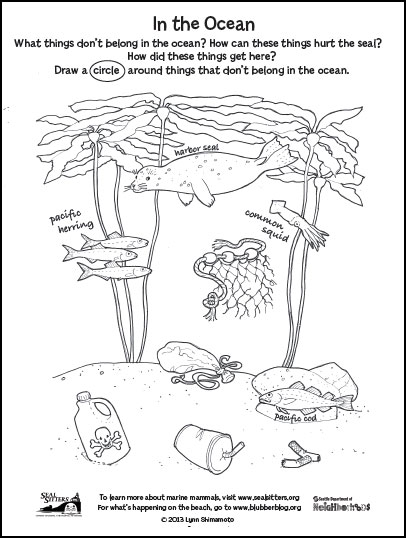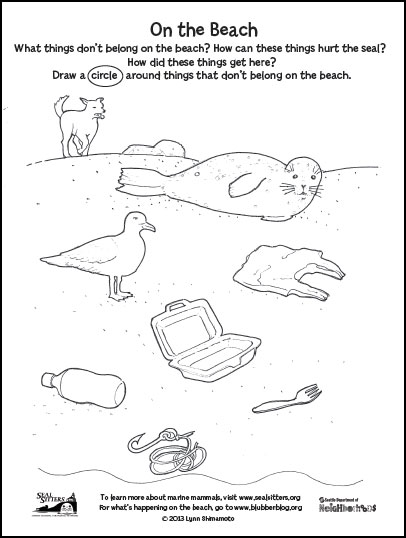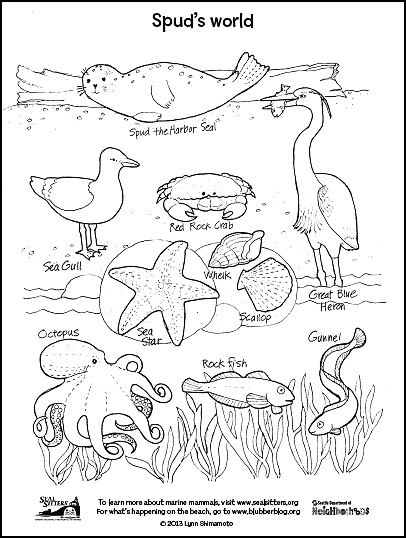KIDSTUFF
SPUD'S FUN FACTS ABOUT HARBOR SEALS
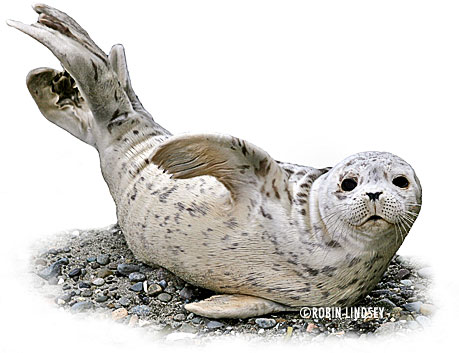 Harbor seals are pinnipeds.
Harbor seals are pinnipeds.
That means they have flippers instead of feet!
They may be clumsy on land, but seals are powerful and very acrobatic swimmers in the water. In fact, they spend about half their time in the water and half on shore, snoozing and warming up.
Seals can sleep underwater.
They can dive very deep - up to 1000 feet, but usually much shallower - and can hold their breath for 25 minutes.
They eat up to 6% of their body weight a day. That’s the equivalent of about 50 quarter lb hamburgers!
They don’t bark like sea lions and are usually quiet and very shy. Baby seals are called pups and make a cry that sounds like “maaaaa.” Click here to listen to a baby seal.
A harbor seal pup can swim and dive shortly after birth.
Seals have really good hearing, so please be quiet if you are observing a pup so he can get some rest.
Harbor seals are as smart as your dog (even smarter than some breeds)! In fact, seals evolved from prehistoric animals very similar to dogs and used to have legs instead of flippers. So, they are Fido's distant cousins!
SPUD'S FUN FACTS ABOUT HARBOR SEALS

That means they have flippers instead of feet!
They may be clumsy on land, but seals are powerful and very acrobatic swimmers in the water. In fact, they spend about half their time in the water and half on shore, snoozing and warming up.
Seals can sleep underwater.
They can dive very deep - up to 1000 feet, but usually much shallower - and can hold their breath for 25 minutes.
They eat up to 6% of their body weight a day. That’s the equivalent of about 50 quarter lb hamburgers!
They don’t bark like sea lions and are usually quiet and very shy. Baby seals are called pups and make a cry that sounds like “maaaaa.” Click here to listen to a baby seal.
A harbor seal pup can swim and dive shortly after birth.
Seals have really good hearing, so please be quiet if you are observing a pup so he can get some rest.
Harbor seals are as smart as your dog (even smarter than some breeds)! In fact, seals evolved from prehistoric animals very similar to dogs and used to have legs instead of flippers. So, they are Fido's distant cousins!
LET'S TALK TRASH!
Trash is dangerous and harms wildlife.
How does trash from land end up in the ocean? How does it hurt marine mammals, sea turtles and other critters?
What difference can you make?
Watch this video by NOAA/Ocean Today and learn how you can help!
Go here to watch some more cool videos.
Trash is dangerous and harms wildlife.
How does trash from land end up in the ocean? How does it hurt marine mammals, sea turtles and other critters?
What difference can you make?
Watch this video by NOAA/Ocean Today and learn how you can help!
Go here to watch some more cool videos.
MARINE TRASH & ACTIVITY COLORING SHEETS
Click on images below to download and print.
©2013 Lynn Shimamoto. All rights reserved.
Click on image above to download and print.
©2013 Lynn Shimamoto. All rights reserved.
YOU CAN HELP!
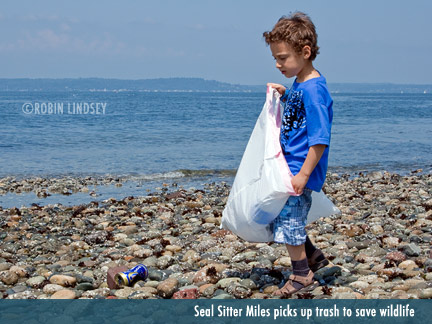 Trash on beaches and in the water (such as plastic bags and balloons) is often mistaken for food by marine mammals and sea birds. Once eaten, the animal can suffer a slow and painful death. Please pick up any trash you find and you may save a life. Mrs. Baker's second grade class in Seattle organized a class field trip to clean up trash on a local beach. Ask your teacher if your class can organize one, too.
Trash on beaches and in the water (such as plastic bags and balloons) is often mistaken for food by marine mammals and sea birds. Once eaten, the animal can suffer a slow and painful death. Please pick up any trash you find and you may save a life. Mrs. Baker's second grade class in Seattle organized a class field trip to clean up trash on a local beach. Ask your teacher if your class can organize one, too.
The kids from Colonial Academy did some research on protecting ocean wildlife and sent Seal Sitters a great resource. Check out all the links on the webpage Protecting Fish and Ocean Wildlife from Pollution.
For lots of other cool resources and links, view Seal Sitters' Marine Debris pdf file.
Seal Sitters' "Let's Talk Trash" flyer tells you how long trash lasts (hint: way too long!) and what you can do to help.
We can all make a difference!

The kids from Colonial Academy did some research on protecting ocean wildlife and sent Seal Sitters a great resource. Check out all the links on the webpage Protecting Fish and Ocean Wildlife from Pollution.
For lots of other cool resources and links, view Seal Sitters' Marine Debris pdf file.
Seal Sitters' "Let's Talk Trash" flyer tells you how long trash lasts (hint: way too long!) and what you can do to help.
We can all make a difference!
BOOKS FOR YOUNG READERS
Seals, other marine mammals and their exotic underwater world are the subject of many children's books, both fiction and non-fiction.
 Leopard and Silkie (One Boy's Quest to Save the Seals) is based on the true story of the friendship of two seal pups who shared the shore in West Seattle - and the Seal Sitters who protect them.
Leopard and Silkie (One Boy's Quest to Save the Seals) is based on the true story of the friendship of two seal pups who shared the shore in West Seattle - and the Seal Sitters who protect them.
Seal Sitters' co-founders, Brenda Peterson (National Geographic author) and Robin Lindsey (photographer) wrote the children's book, as well as the early reader edition, Seal Pup Rescue. Read more on the book website about the backstory and how children can protect wildlife.
One of Seal Sitters' favorites is Water Beds: Sleeping in the Ocean, a dreamy tale of how marine mammals sleep as seen through a young boy's eyes. Adult seals and their pups are able to sleep underwater because their nostrils close, but they still need to surface at regular intervals to breathe.
For Seal Sitters' complete list of recommended books for kids (and adults), please click here and learn more about our marine mammal friends.
Seals, other marine mammals and their exotic underwater world are the subject of many children's books, both fiction and non-fiction.
 Leopard and Silkie (One Boy's Quest to Save the Seals) is based on the true story of the friendship of two seal pups who shared the shore in West Seattle - and the Seal Sitters who protect them.
Leopard and Silkie (One Boy's Quest to Save the Seals) is based on the true story of the friendship of two seal pups who shared the shore in West Seattle - and the Seal Sitters who protect them.Seal Sitters' co-founders, Brenda Peterson (National Geographic author) and Robin Lindsey (photographer) wrote the children's book, as well as the early reader edition, Seal Pup Rescue. Read more on the book website about the backstory and how children can protect wildlife.
One of Seal Sitters' favorites is Water Beds: Sleeping in the Ocean, a dreamy tale of how marine mammals sleep as seen through a young boy's eyes. Adult seals and their pups are able to sleep underwater because their nostrils close, but they still need to surface at regular intervals to breathe.
For Seal Sitters' complete list of recommended books for kids (and adults), please click here and learn more about our marine mammal friends.
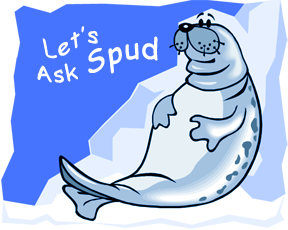
Ryo, age 5, from Philadelphia asks Spud:
"Do you know any seals in Japan?"
"Dear Ryo,
Seals live all over the world! In Japan alone there are many different species of seals, including harbor seals like me. So, I have lots of friends and relatives in the Far East. Since I live in Puget Sound, we stay in touch by "seal phone"!
Flipper hugs,
Spud"
Etienne, age 8, from Seattle wants to know:
"What is the most likely way for a seal to get injured?"
"Dear Etienne,
Seals are food items on the menu of large sharks and killer whales (orcas). That is one way to get injured....or eaten! On the beach, seals can be targets of land "predators" (seals are "prey" animals) such as bears, wolves, coyotes and eagles. Fishing nets are a very serious risk for seals (and other sea life) and can injure us as we struggle to get free - and often hold us under water until we drown. Seals are injured by high speed boats that run into us, so boaters need to slow down and watch out for marine mammals. Trash on the beach and in the water is a danger for us because we think it's food and can die from eating it. Chemicals that pollute our waters make us sick. Yikes, now that I think about it, there's lots of risks for us out there! Why, seals are even sometimes illegally shot by people who blame us for eating fish. Hey, we've gotta eat, too! Thanks for helping to protect us.
Flipper hugs,
Spud"
Do you have a question for Spud? If so, email him here. Please let Spud know your name and age (and thanks to our seal interpreters!).
